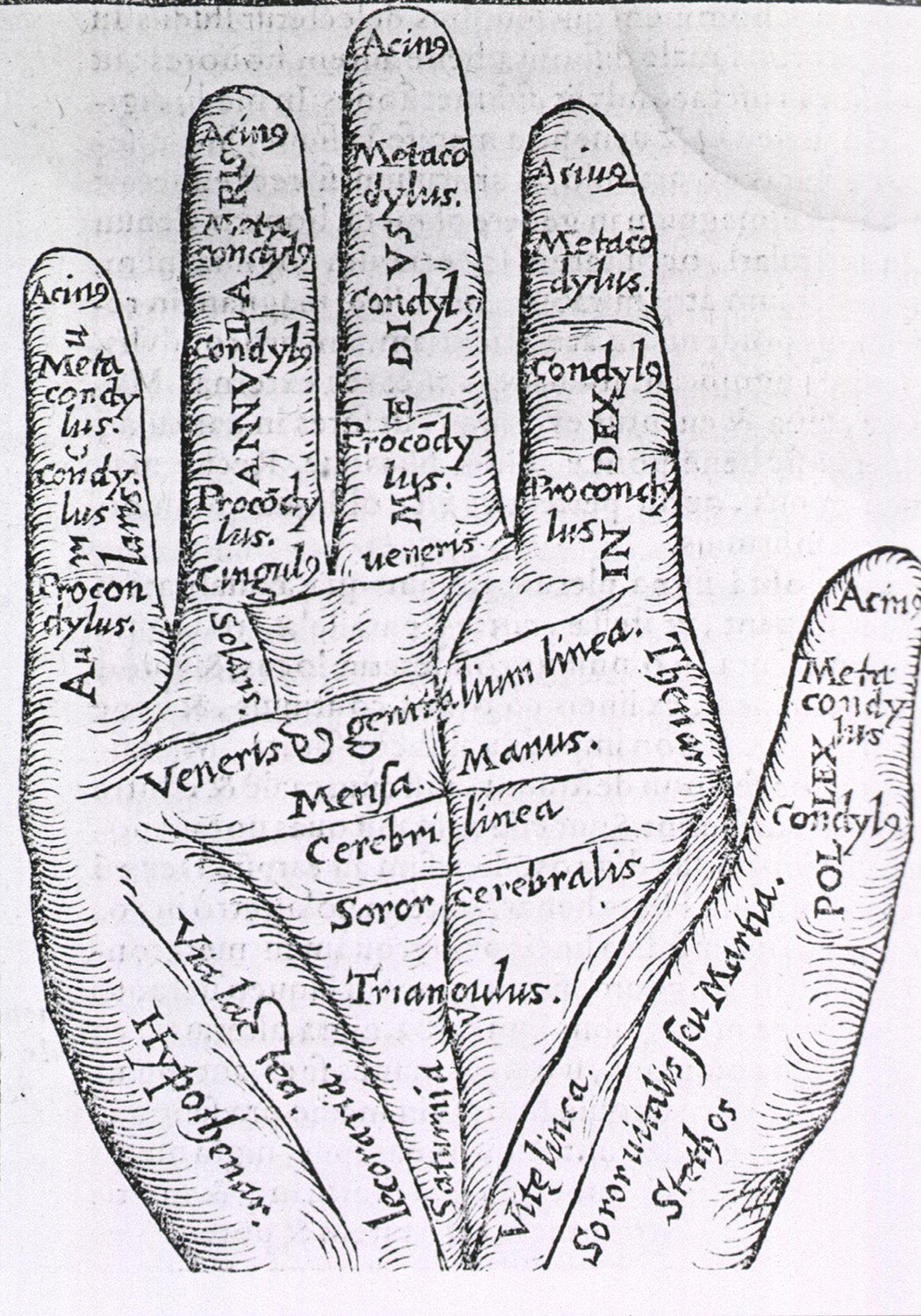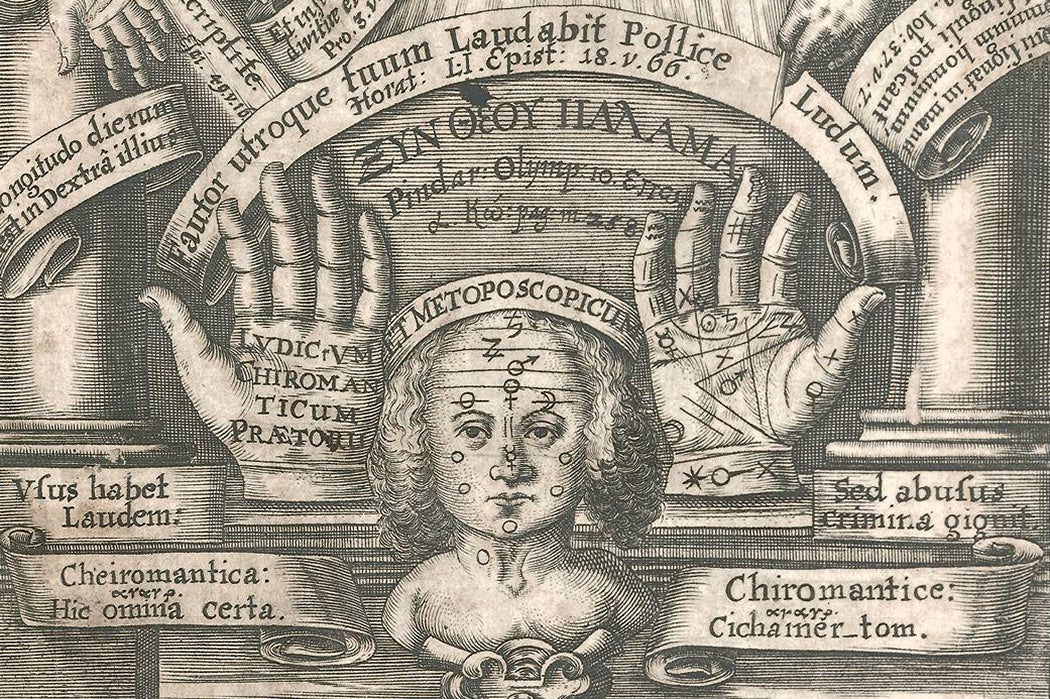In a recent episode of Marvel’s delightfully witchy series Agatha All Along, Joe Locke’s character is seen in flashback at his bar mitzvah, entering what he thinks is a novelty fortune-telling tent. Inside, actual witch Lilia (Patti LuPone) grasps his hand and proclaims that his lifeline is split in two, foretelling drama to come.
Palm reading, also known as palmistry or chiromancy throughout history, has been far more than a party trick for centuries. Dating back to classical antiquity, the idea that a soothsayer can tell something about a person’s health, disposition, or destiny from the lines on their palm has long fascinated seers and scientists alike.
Classicist Charles S. F. Burnett finds mentions of chiromancy in various ancient texts, including in Aristotle’s writing, but the practice of palm reading seems to have disappeared in the Western world between the classical era and the twelfth century. In an interesting blend of disciplines, records of the practice appear not only in scientific or magical writings but in religious text, too. Readers were advised that certain marks are auspicious.
“When it extends as far as the first finger, he will be a monk,” read a Latin chiromancy manuscript. “This mark is the sign of a parish income (presbyterium)…. This is a sign of someone being elected or freely blessing.”
Writers from Albertus Magnus and Thomas Becket to Thomas Aquinas and Paracelsus had engaged with the practice, trying to determine if it was real or bunk and what the commonly agreed rules might be. Writing in the middle of the twentieth century, Renaissance literature scholar Carroll Camden summarized the most common suppositions, noting that “there are five principle lines in the hand: (1) the table line or line of fortune, (2) the natural line, (3) the line of life or of the heart, (4) the line of the liver or stomach, and (5) the sister line or line of death.” Many seekers legitimized their affinity for palm-reading with Biblical references (a passage from Proverbs, for example, advised “Length of days is in her right hand; and in her left hand riches and honour.”). And by the Elizabethan era, chiromancy was well known, sitting between religion and magic in both the popular and scholarly consciousness (in Act III, Scene 4 of Shakespeare’s Othello, he title character holds Desdemona’s hand and muses, “This argues fruitfulness and liberal heart.”)

Palm reading became popular in the United States, particularly in the nineteenth century, as a general vogue for séance, mediumship, spirit photographs, and the occult took hold. The combination of cultural individualism, industrialization, and technological advance created a cultural moment in which audiences were open to and actively explored the idea of unseen forces (hey, if telegraph and photography worked, why not mesmerism, spiritualism, or palm-reading?).
In America, certain stereotypes came to prevail when it came to occult practices. Though men also engaged with fortune-telling and spiritualism, women remained the popular image of the practice. This was in part because the era’s gender norms often cast women as sentimental, close to nature, and inherently passive—an ideal channel for spiritual energies. As a result, though, women were allowed to center themselves within spiritualist movements, making a livelihood and speaking on subjects that may have been off-limits if not for the will of the “spirits.”
Still, longstanding cultural associations with witchcraft affected how palm-readers were seen. F. Wright, writing for the monthly arts magazine The Aldine, described a fortune-telling palm-reader as a
wandering crone [who] has learned her lesson well, and her own palm has been crossed by the mighty magician that has let fall the scales from human eyes ever since “Adam delved and Eve span.” There is a cunning leer, too, in [her] wrinkled face—a wise expression about the toothless mouth, even the posture itself is in excellent keeping.
Origin stories touted fortune-tellers as “born with cauls” or “the seventh daughter of a seventh daughter” in an effort to add to their witchy mystery.
Scientists tried to engage with the idea of chiromancy, just as they did with other pseudosciences such as phrenology and craniometry. In 1848, the anonymous author of book The Hand Phrenologically Considered justified the use of the hand as a diagnostic tool. Since
the capacities, powers, and general habits of an animal, must be in correspondence with this part of its organization, when we are acquainted with the form and arrangement of the extremities of an animal, a key is thereby afforded to its entire organisation.
As with many of the pseudosciences of the era, chiromancy was highly racialized and used the veneer of science to suggest inherent, biological white superiority. It was convenient and easy to suggest a correlation between physical characteristics and a person’s disposition, potential, or status. And often, the practice of palm-reading itself was racialized: as late as the 1960s, palm readers were being cast as “gypsy” women in an effort to suggest an exotic “other.”
Nonetheless palm-readers were popular. Fortune-tellers were happy to advise on matters ranging from healing and questions of love, to gambling and business advice. An 1895 a study of advertisements for mediums and chiromancers discussed a wide range of promises made by practitioners, from “‘healing troubles,’ ‘reuniting lovers,’ ‘removing bad habits,’ ‘restoring lost love by sympathy,’ ‘true pictures of future wives and husbands,’ and of ‘lucky numbers’ for those who play policy and speculate in lotteries.” (Teachers were also apparently not above using a little chiromantic razzle-dazzle to get their kids to behave in the classroom.)
Weekly Newsletter
Skeptics persisted, however. Of the Handbook of Modern Palmistry in 1884, a reviewer groaned: that “although [it was] written apparently with something curiously like an honest intent, this book is a piece of absurd claptrap.” Acknowledging that occult disciplines “mark the remains of the old truth-searching impulse” which moved humans from superstition into genuine learning, the author lumped chiromancy in with astrology, dream interpretation, and reading entrails. Even the most intelligent of folks were tempted by the chance to pierce the veil, noted the critic. In the 1880s, in scholarly Cambridge, Massachusetts,
a professed divinator has kept for years a large business-like and soberly worded advertisement of his services. The circulation of this paper is not among the lower classes: on the contrary, its principal clientele is among the more intelligent people.
So even the highly educated were hopeful that their palms would lead them to good fortune.







